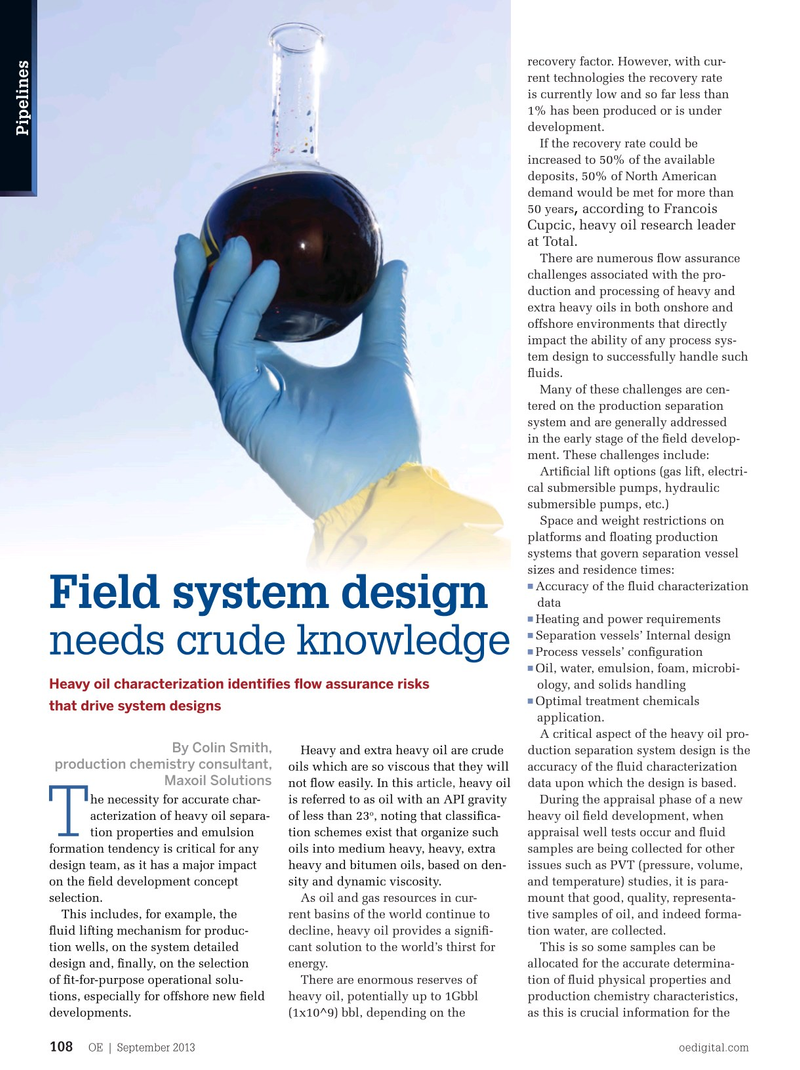
Page 106: of Offshore Engineer Magazine (Sep/Oct 2013)
Read this page in Pdf, Flash or Html5 edition of Sep/Oct 2013 Offshore Engineer Magazine
recovery factor. However, with cur- rent technologies the recovery rate is currently low and so far less than 1% has been produced or is under development.
Pipelines
If the recovery rate could be increased to 50% of the available deposits, 50% of North American demand would be met for more than 50 years , according to Francois
Cupcic, heavy oil research leader at Total.
There are numerous fow assurance challenges associated with the pro- duction and processing of heavy and extra heavy oils in both onshore and offshore environments that directly impact the ability of any process sys- tem design to successfully handle such fuids.
Many of these challenges are cen- tered on the production separation system and are generally addressed in the early stage of the feld develop- ment. These challenges include:
Artifcial lift options (gas lift, electri- cal submersible pumps, hydraulic submersible pumps, etc.)
Space and weight restrictions on platforms and foating production systems that govern separation vessel sizes and residence times: n
Accuracy of the fuid characterization data
Field system design n
Heating and power requirements n
Separation vessels’ Internal design needs crude knowledge n
Process vessels’ confguration n
Oil, water, emulsion, foam, microbi- ology, and solids handling
Heavy oil characterization identifes fow assurance risks n
Optimal treatment chemicals that drive system designs application.
A critical aspect of the heavy oil pro-
By Colin Smith,
Heavy and extra heavy oil are crude duction separation system design is the production chemistry consultant, oils which are so viscous that they will accuracy of the fuid characterization
Maxoil Solutions not fow easily. In this article, heavy oil data upon which the design is based. he necessity for accurate char- is referred to as oil with an API gravity During the appraisal phase of a new o acterization of heavy oil separa- of less than 23 , noting that classifca- heavy oil feld development, when tion properties and emulsion tion schemes exist that organize such appraisal well tests occur and fuid
T formation tendency is critical for any oils into medium heavy, heavy, extra samples are being collected for other design team, as it has a major impact heavy and bitumen oils, based on den- issues such as PVT (pressure, volume, on the feld development concept sity and dynamic viscosity. and temperature) studies, it is para- selection. As oil and gas resources in cur- mount that good, quality, representa-
This includes, for example, the rent basins of the world continue to tive samples of oil, and indeed forma- fuid lifting mechanism for produc- decline, heavy oil provides a signif- tion water, are collected. tion wells, on the system detailed cant solution to the world’s thirst for This is so some samples can be design and, fnally, on the selection energy. allocated for the accurate determina- of ft-for-purpose operational solu- There are enormous reserves of tion of fuid physical properties and tions, especially for offshore new feld heavy oil, potentially up to 1Gbbl production chemistry characteristics, developments. (1x10^9) bbl, depending on the as this is crucial information for the
OE | September 2013 oedigital.com 108 000_OE0913_pipelines_maxoil.indd 108 8/17/13 5:53 PM

 105
105

 107
107